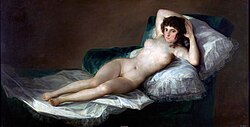Francisco de Goya was a Spanish artist famous for creating
art from subjects that were considered taboo in his era, such as naked women,
war, and scary images. He served as court painter to royal family in Spain,
making him become extremely popular at the time. His work is often seen as
documentation and explanation of Spanish history during his life. As an artist,
he had two distinct styles: originally his art used natural colors and focused
on casual aristocratic life, ranging from celebrations to people, but he
eventually changed to a much darker style to depict war and create emotions of
fear and suffering. These pieces of art, often paintings, are still widely
appreciated, with many on display at El Museo Del Prado in Madrid.

Charles IV of Spain and his family, 1800
The above picture is one of Charles IV that he painted
during his time as court painter. The picture uses natural colors and accurate
portrayals of each person in the family to create a real view of what each of
them looked like. He is unique in that he did not exaggerate any features of
the people to make them look better, as he intended to be as accurate as
possible. Furthermore, he did not use positions of power or any sort of
pictorial elements to make them seem grander than they were. In doing so,
viewers could see exactly what the emperor looked like.


La Maja Desnuda (top), 1800, and La Maja Vestida (bottom),
1803
Two of his most famous pieces of art are the Maja Desnuda
and Maja Vestida, both of the same woman in the same pose, only one is naked
while the other is not. They likely were paintings of the Duchess of Alba,
though this has not been confirmed. La Maja Desnuda was a revolutionary
painting in that it was one of the first depictions of a naked female with no
censorship. Features such as her pubic hair and breasts were kept realistic, as
in his paintings of the royal family, to accurately depict his subject, even
though it was an uncommon one. He later followed up with the Maja Vestida to represent
a more chaste version of the same woman, and he used a very similar style to
create almost a clone image, only with clothes. Originally considered obscene
when obtained by the Spanish Inquisition, these paintings are still on display
in El Museo Del Prado.

Que hai que hacer mas? 1810-14
After the Peninsular War started in Spain in 1808, Goya’s
style became much darker in content. He depicted the horrors of the war in his
series of drawings called The Disasters
of war. The picture above is one from this series and depicts graphic
violence reminiscent of war. Goya intended to show the horrors of war with this
series, which is why he made it so graphic. Other artwork from this set show
people being shot, blood, and other acts of violence and are generally darker
in color. In doing this, he switched his style of art to exaggerate the scenes
and place extra emphasis on the damage the war caused.

Saturn Devouring his son, 1819-1823
Later in his life, Goya started to lose his mental aptitude
and became mentally unstable, prompting his series of Black Paintings. The
subjects of these pieces of art were extremely haunting and/or disturbing,
often using jackals, demons, looks of torment, and violence, and used dark
colors to make the art appear creepier. Perhaps his most famous piece of art Saturn devouring his son was created in
this time. Other artists had drawn this scene, such as Peter Paul Rubens, but
they do so in a humane way. Goya’s rendition is famous for the graphic
depiction of the act and the horrific look on Saturn’s face. One of the most
memorable pieces of art to see in person, this painting is a reflection of
horror and easily instills fear just by looking at it. This, along with the
rest of the black paintings, displays his insanity and his dreary output on
life, which may have been caused by war and his loss of mental stability.
Goya is my favorite artist because of his wide variety of
style and subjects; in my opinion, no other artist has quite as much of an
array of art as him. His work in the early stages of his career attempted to
display reality as it was, even if the subject matter was unusual or frowned
upon. He later switched to an exaggerated style to convey graphic images that
expressed his innermost emotions, something many artists do with happiness or
sadness, but less commonly with anger and fear. Personally, having seen many of
his pieces of art in El Museo del Prado while I studied abroad in Madrid, I
think his art, especially the Black Paintings, are extremely powerful. Although
intense and almost scary to look at, I created lasting memories observing them
in person. They also have left a long lasting impact on my style of art, as I tend
to draw very expressively partially to cover missed lines, but also to make the
drawings have more emotional investment. My subject matter is also reminiscent
of the Black Paintings, as many of my sketchbook drawings are of dragons,
demons, or monsters of some sort. His impact on me has been larger than that of
any other artist and I admire him strongly for his variety of work and emotional
display of taboo subject matter.
“Charles IV of Spain and his family.” Francisco de Goya. Web
04 Oct. 2014. http://en.wikipedia.org/wiki/File:Francisco_de_Goya_y_Lucientes_054.jpg
“La Maja Desnuda.” Francisco de Goya. Web 04 Oct. 2014. http://en.wikipedia.org/wiki/File:Goya_Maja_naga2.jpg
“La Maja Vestida.” Francisco de Goya. Web 04 Oct. 2014. http://en.wikipedia.org/wiki/File:Goya_Maja_ubrana2.jpg
“Que hai que hacer mas?” Francisco de Goya. Web 04 Oct.
2014. http://en.wikipedia.org/wiki/File:Prado_-_Los_Desastres_de_la_Guerra_-_No._33_-_Que_hai_que_hacer_mas%3F.jpg
“Saturno Devorando a su hijo.” Francisco de Goya. Web 04
Oct. 2014. http://en.wikipedia.org/wiki/Saturn_Devouring_His_Son#mediaviewer/File:Francisco_de_Goya,_Saturno_devorando_a_su_hijo_(1819-1823).jpg
No comments:
Post a Comment